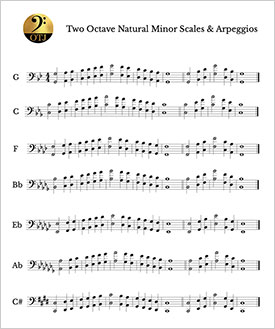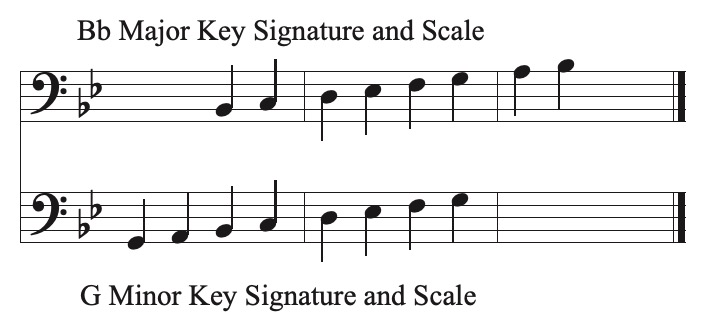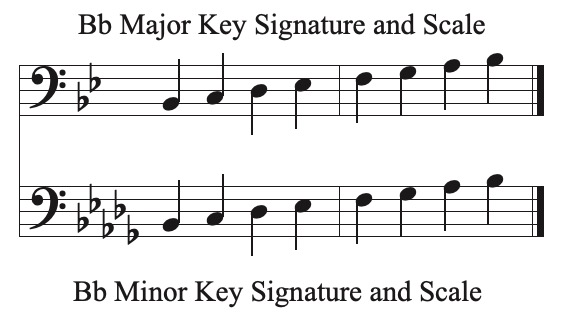Two Octave Natural Minor Scales and Arpeggios
 Get the Two Octave Natural Minor Scales & Arpeggios PDF
Get the Two Octave Natural Minor Scales & Arpeggios PDF
After the major scales and arpeggios, the natural minor scales and arpeggios are the second-most used scales and chords in Western classical music, jazz, and rock. If you have memorized your major scales and arpeggios and know their key signatures, then you already know the natural minor scales and arpeggios!
Relative Minor
Your experience in major keys means you already know the natural minor counterparts. Below is the B♭ major and G natural minor scales and arpeggios. Notice that these have the same key signature all the same pitches, they just begin on different places in the scale. The relative minor scale will always begin on the sixth note (or scale degree) of its relative major scale. In this case, the sixth scale degree of B♭ major is G. The relative minor scale of B♭ major would begin and end on the pitch G, and use the key signature of B♭ major.
We can say that G minor (the scale and the key) is the relative minor of B♭ major. This is the primary way we think about the relationship between major and minor keys.

Parallel Minor
The second way we can talk about the relationship between major and minor is when the starting pitch is the same for both, but then key signature has to change. We can call this a parallel relationship. For example: B♭ major and B♭ minor both begin on B♭, but the two scales will have different key signatures so that the scales sound differently, even though they both begin on B♭. B♭ minor is the parallel minor to B♭ major. To make a major scale into a minor scale, add three flats to the key signature. You can also think about lowering the third, sixth and seventh scale degrees one half step.

Practice Thoughts
However you think about the relationship of major and minor scales, there are some important practice thoughts to keep in mind as you learn this new scale form.
- The minor scales and arpeggios have a different order of whole and half steps than the major scales and arpeggios, they sound different in important ways. While your ear adjusts to this new sound, attention to intonation is important. Use your tuner and practice drones to guide your ear and slide.
- All the practice advice from our Two Octave Major Scales & Arpeggios article applies to these minor scales and arpeggios. Namely: have a consistent breathing pattern, start slow then increase tempo when these scales and arpeggios are easy, vary dynamics and articulation styles, and record yourself on a regular basis. And of course, always sound great!
Finally, for those wanting to dive deeper into music theory, MusicTheory.net has well-paced and effective lessons and exercises on major scales, minor scales, scale degrees, and key signatures. The more you know about the language of music the more fluent you will be in performing! These are especially recommended for those seeking to pursue a music major in college and/or a professional career in music.
